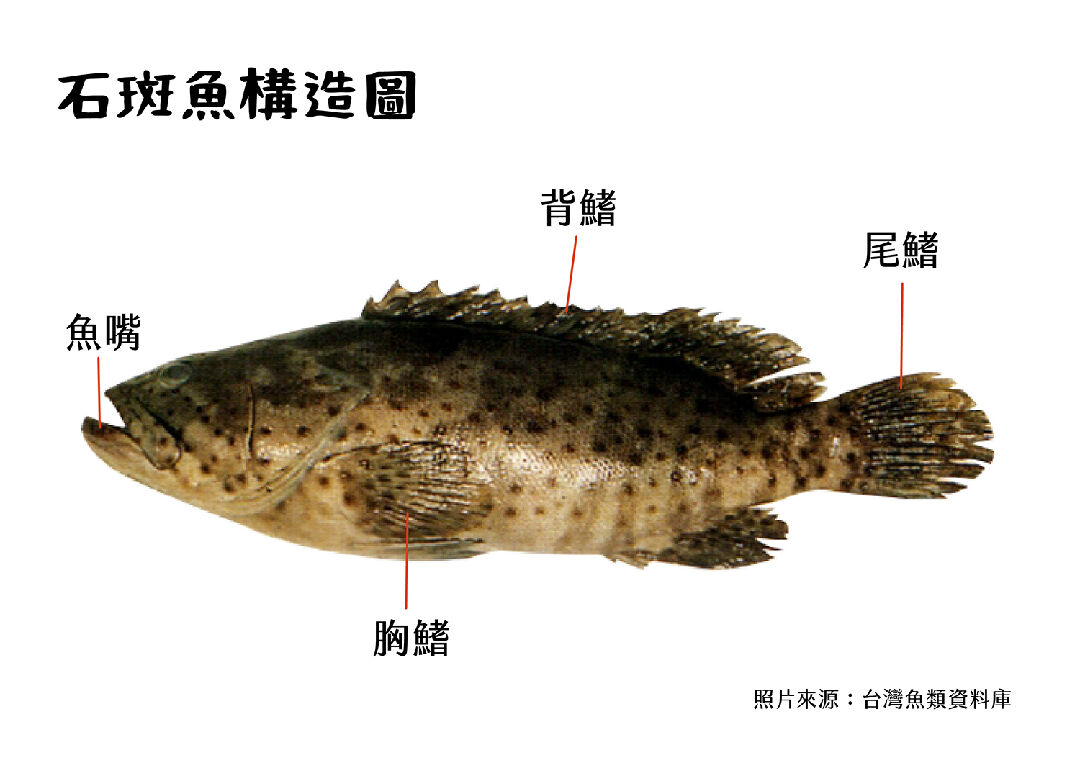石斑魚的分類簡介
石斑魚(genus Epinephelus)隸屬於鱸形目(Perciformes)、鮨科(Serranidae)、石斑魚亞科(Epinephelinae),是海洋中分布廣泛且種類繁多的一類魚類。根據 Nelson(2006) 的分類,全球鮨科可分為三個亞科(subfamily),包含約 64 屬、475 種以上的魚類,其中石斑魚所屬的石斑魚亞科(Epinephelinae),又可細分為五個族(tribe):
- 東洋鱸族(Niphonini):1 屬 1 種
- 石斑魚族(Epinephelini):約 15 屬 100 種,其中石斑魚屬(Epinephelus)為最具代表性的類群
- 黃鱸族(Diploprionini):3 屬 5 種
- 長鱸族(Liopropomini):3 屬
- 黑鱸族(Grammistini):8 屬約 21 種
在台灣海域,目前記錄到的鮨科魚類共3 亞科 31 屬 121 種。其中,石斑魚屬(Epinephelus)是台灣水產養殖與漁業資源中最具經濟價值的類群,包含多種高經濟價值的魚種,如點帶石斑(E. coioides)、棕點石斑(E. fuscoguttatus)、鞍帶石斑(E. lanceolatus),這些物種廣泛分布於珊瑚礁、岩礁及沿岸水域,並在台灣養殖業中占有重要地位。
石斑魚在外觀上一般來說都是稍微側扁,然後成紡錘形或者是橢圓形,體上有覆蓋著細小圓鱗,頭部較大亦被有鱗片。體側具有單一條側線並呈彎曲形的弧線,口部極大且呈現平裂狀或稍微傾斜狀,上頷骨能自由活動並可稍微的向前伸出,用來將食物吸入口部,同時具有輔助用的上頷骨。上下兩頷前端有很尖利的圓錐狀尖牙,而位於兩側的牙齒較細,有些向內側斜向生長,內側的犁骨和顎骨都生有絨毛狀細牙,而舌頭部份則呈平滑無細齒。前鰓蓋骨邊緣具有鋸齒狀的突起,有些則較為平滑,鰓蓋骨具有2-3根扁平棘刺。尾鰭形狀呈圓形、截平形或凹入形。胸鰭呈圓形或三角形,無硬棘 (邵,2023)。

Groupers (genus Epinephelus) belong to the order Perciformes, family Serranidae, and subfamily Epinephelinae. They are a diverse group of marine fish found in tropical and subtropical waters worldwide. According to Nelson (2006), the Serranidae family is divided into three subfamilies, consisting of approximately 64 genera and over 475 species. The Epinephelinae subfamily, which includes groupers, is further classified into five tribes:
- Niphonini: 1 genus, 1 species
- Epinephelini: About 15 genera and 100 species, with Epinephelus being the most well-known
- Diploprionini: 3 genera, 5 species
- Liopropomini: 3 genera
- Grammistini: About 8 genera and 21 species
In Taiwan, 31 genera and 121 species of Serranidae have been recorded. Among them, Epinephelus species are highly valued in the fishing and aquaculture industries. Some economically important species include orange-spotted grouper (E. coioides), brown-marbled grouper (E. fuscoguttatus), and giant grouper (E. lanceolatus). These fish are commonly found in coral reefs, rocky reefs, and coastal waters, and they play a key role in Taiwan’s aquaculture industry.
Groupers generally have a slightly compressed body, which is fusiform (spindle-shaped) or oval-shaped. Their bodies are covered with small, round scales, and their large heads are also covered in scales. They have a single lateral line running along their sides in a curved shape.
Their mouths are large, slightly slanted, and can extend forward to suck in prey. Their upper jaw is flexible and supported by an extra jawbone. Sharp conical teeth are present at the front of both jaws, while smaller teeth along the sides may be slightly inward-facing. Vomerine and palatine teeth are present in the mouth, but the tongue is smooth.
The edge of the preopercle (part of the gill cover) is serrated, though in some species, it is smoother. The operculum (gill cover) has 2–3 flat spines. Their tail fins can be rounded, truncated, or slightly concave, while their pectoral fins are rounded or triangular and lack spines.